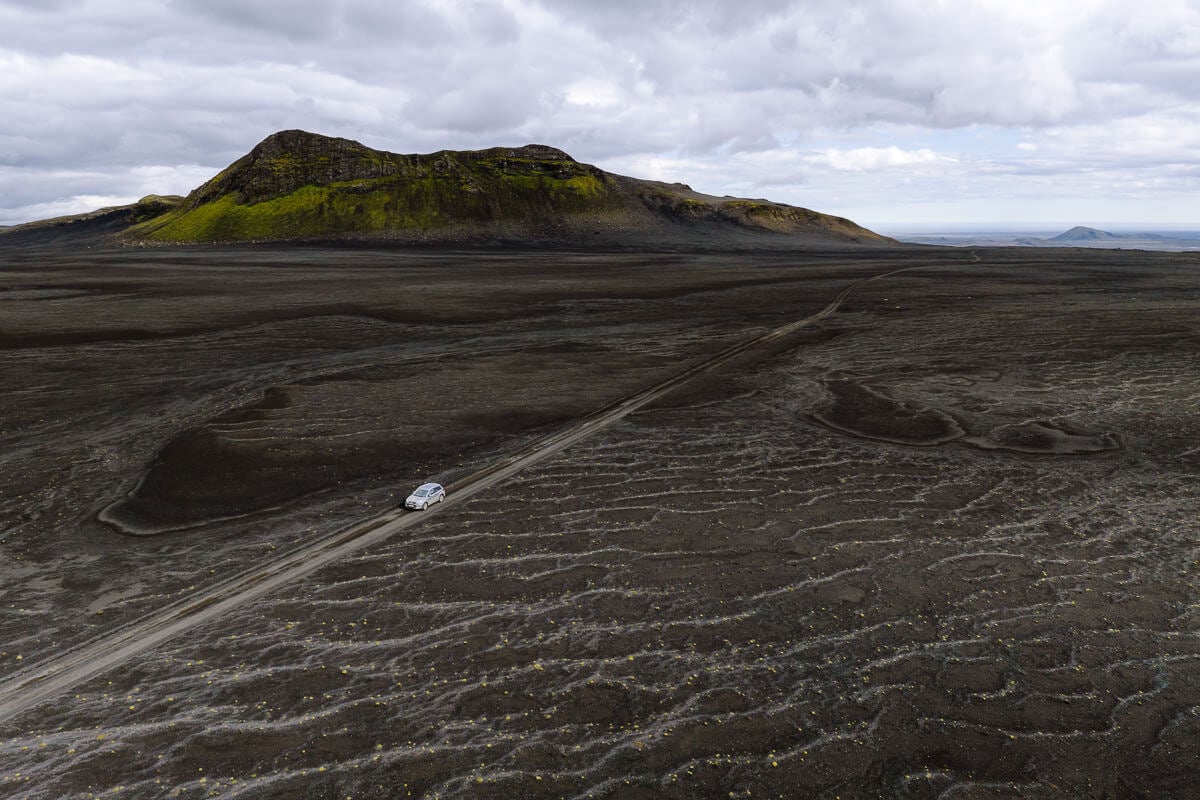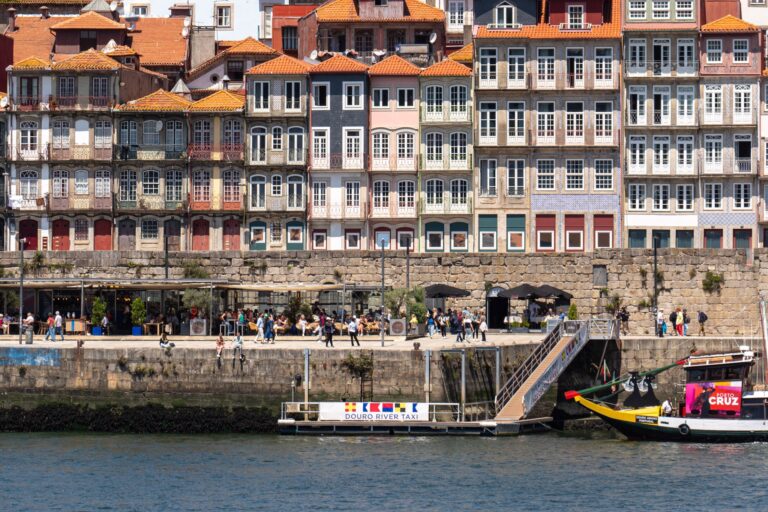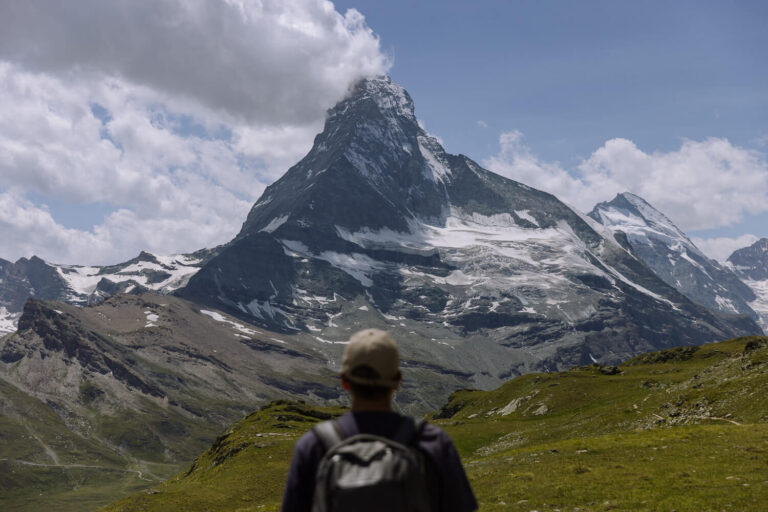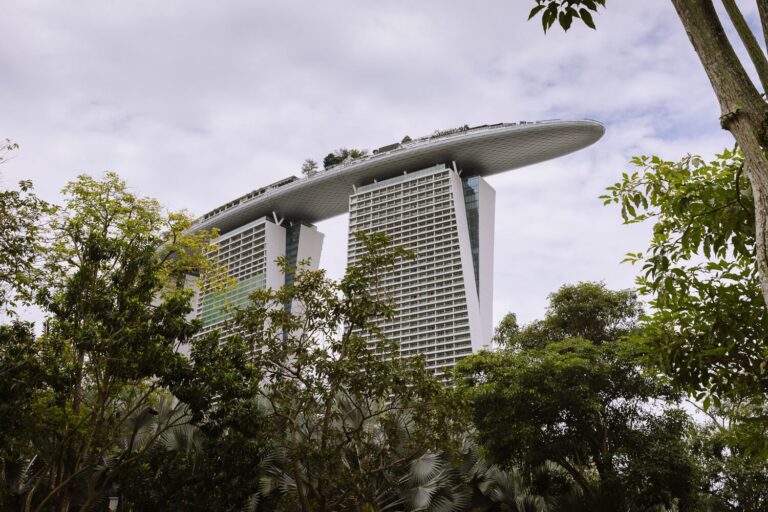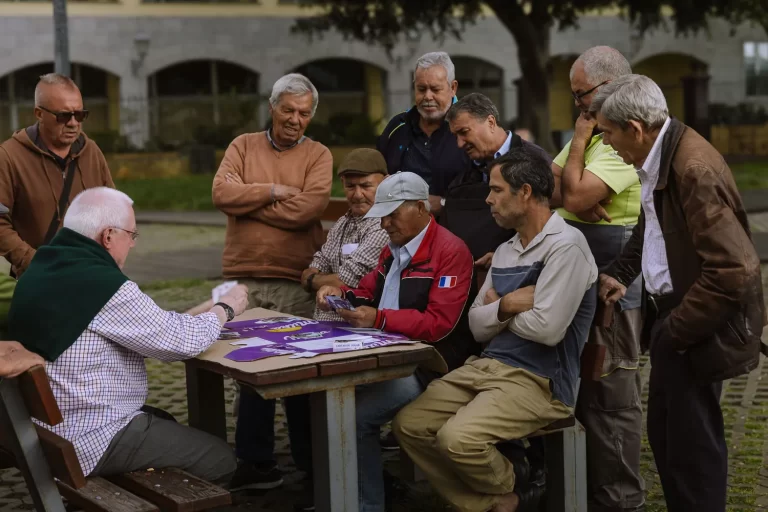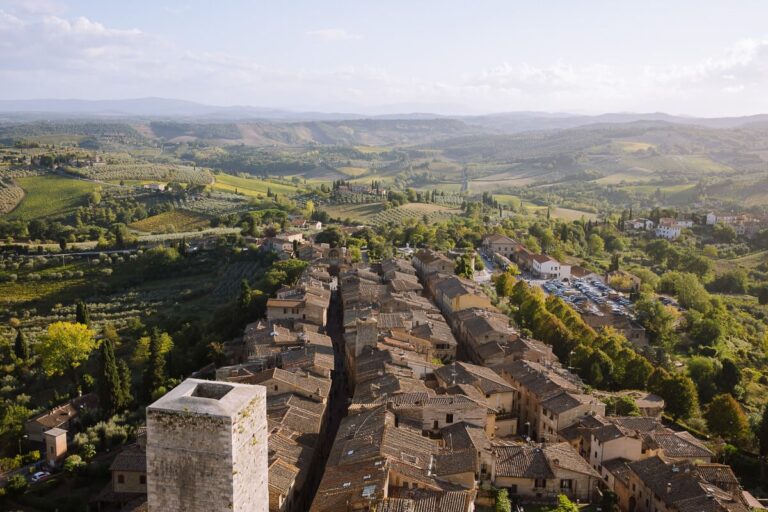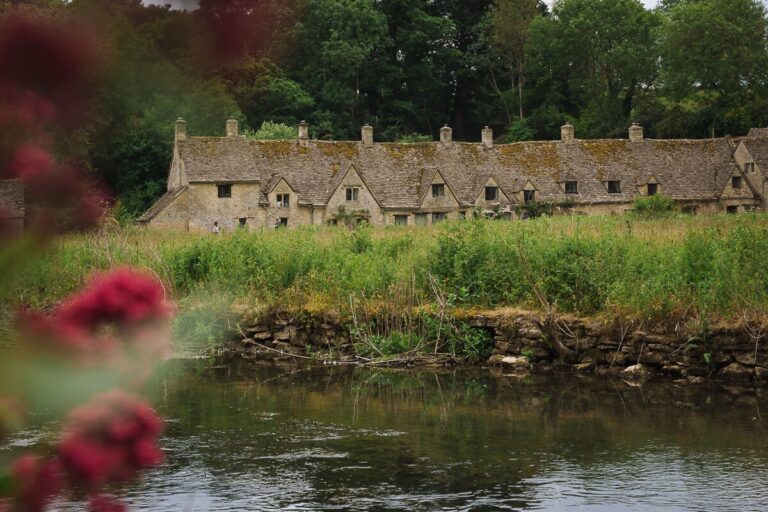The F-Roads In Iceland Guide – All You Need To Know + Popular Routes | Anywhere We Roam
Driving the F-Roads in Iceland gets you off the beaten track and into amazing, barren scenery. But navigating these mountain roads can be challenging. Here’s all you need to know about driving on the F-roads in Iceland.
LAST UPDATE: 30 Oct 2023
Anywhere We Roam is reader-supported. When you buy through links on our site, we may earn a small affiliate commission at no extra cost to you. Thanks for your support – Paul & Mark.
Some of the unique beauty of Iceland can be seen from the Ring Road, but much more lies in the desolate center of the country – the highlands.
To get into the Iceland highlands, you need to go on an F-road, or mountain road.
The F-Roads in Iceland are rough and ungraded gravel tracks that are only accessible in 4×4 vehicles,
After 4 visits to the highlands, we’ve learnt a lot about driving on the F-Roads.
These exciting roads have taken us to some remarkable places. Volcanos surrounded by vast open plains. Massive caldera systems in the middle of nowhere. Waterfall-fed hot springs alongside enormous canyons.
This guide includes everything you need to know for driving on the F-Roads in Iceland. We cover the type of vehicle you need, tips for crossing rivers, plus the most popular f-roads you are likely to go on.

IN THIS GUIDE
DRIVING THE F-ROADS IN ICELAND
WHAT ARE THE F-ROADS IN ICELAND?
The F-roads are unpaved gravel tracks that only open during the summer months and are only accessible in a 4×4 SUV vehicle. Most F-roads criss-cross the mountainous central region of Iceland called the highlands – the “F’ comes from fjall which means mountain in Icelandic.
Some F-roads are good-quality gravel roads that will allow for speeds of up to 80 kilometres per hour (50 miles per hour) in places. Others are much more adventurous and involve fording (crossing) rivers, extremely rocky terrain and driving over sand.
Most have potholes, ruts and boulders that need to be navigated.
The F-roads in Iceland are remote with almost no facilities. You will rarely come across a shop, gas station or hotel.

F-ROADS IN ICELAND MAP
The majority of the F-roads in Iceland connect the popular Ring Road (Highway 1 or Þjóðvegur 1) route with the mountainous central highlands area of the country. The below map provides an overview of all the F-Roads in Iceland.

WHAT VEHICLES ARE ALLOWED ON THE F-ROADS IN ICELAND?
The tricky nature of the roads and changing weather conditions in the highlands means that only 4-wheel drive vehicles (sometimes called AWD or 4WD ) can drive on the F-roads.
In addition, there are 3 other mountain roads that are not prefixed with an F, but also require a 4WD vehicle. They are: Kaldidalur Valley (road 550), Kjölur (road 35) and Jökulhálsleið (road 570).
It’s illegal to drive on the F-roads in a 2-wheel drive car or in a 4WD passenger car and rental companies will not insure you. If you incur damage to a normal passenger car while driving on the F-roads you will not be covered by insurance.


HOW DIFFICULT ARE THE F-ROADS IN ICELAND TO DRIVE?
Different F-roads present different challenges. Some are smooth gravel tracks where you can speed along at 80 kilometres per hour whereas others rise steeply up mountains and over rocky boulders.
Some cross small shallow streams whereas others traverse much deeper and faster-flowing rivers.
Conditions on the mountain roads can also change quickly. What was a stream in the morning can be a river on your return trip. Bright sunny days can very quickly turn to thick clouds and mist, making visibility poor and the edges of the road indistinct.
All the F-roads in Iceland require good levels of concentration at all times and driving them can be a challenge.
WHEN ARE THE F-ROADS OPEN?
The F-roads are only open during summer. Opening times vary based on the weather and each road has a different opening time based on the conditions in that particular area. Most F-roads open around the middle of June, with a few opening at the start of June and some not opening until early July.
Predicted opening times are available on the Road.is website.


IS DRIVING ON THE F-ROADS IN ICELAND WORTH IT?
Yes, there are three great reasons to drive the F-roads of Iceland.
Firstly, they get you to some of the most breathtaking scenery in Iceland. Expect to see beautiful rainbow-coloured mountains, canyons cut deep into expansive barren landscapes, huge waterfalls miles from anywhere else, geothermally active lava fields, and remote natural pools.
There are volcanos and glaciers; sandy deserts and huge lake-filled calderas and there’s nothing quite like it anywhere else.
Secondly, most tourists stay in the southwest of Iceland or circle the Ring Road making these destinations busy. Head onto the F-roads and you’ll be rewarded with some of the best scenery the country has to offer with far fewer visitors.
Thirdly, driving the F-roads in Iceland is an adventure in itself. The roads are natural and unkempt; navigating them requires 4×4 skills you’ll soon start to master. It’s a lot of fun and because different F-roads present different challenges it can be as difficult and exciting as you want.
For a mild adventure stick to easier F-roads and buzz along gravel tracks. For a more exciting challenge head to more difficult F-roads driving over boulders, crossing lava fields and fording rivers.


WHERE CAN YOU GET TO ON THE F-ROADS
We have put together a guide covering the best places to visit in the Iceland Highlands that can only be reached by traveling on an F-road. Some of our favorites are:


DIFFERENT CONDITIONS ON THE F-ROADS
Each F-road in Iceland involves unique challenges. It’s important to understand the different types of F-roads to assess how comfortable you are driving on them and to determine what type of preparation you need to consider before you set off.
EASIER F-ROADS
Easy F-Roads are little more than undulating gravel tracks, with no river crossings. For these roads, inexperienced 4X4 drivers should have no problem in any sized 4WD vehicle.
MEDIUM F-ROADS
Medium F-roads present more of a challenge due to stony sections, shallow sand, and river crossings of at least 20 – 40 centimetres deep. Experience is not required, but we recommend trying some easy F-roads first and to hire at least a medium-sized 4×4 vehicle.
CHALLENGING F=ROADS
Challenging F-Roads are very steep and filled with boulders and/or require crossings through more significant, faster-flowing rivers of around 40 – 60 centimetres deep.
These roads are often not suitable for small or medium 4×4 vehicles and require higher clearance and an experienced driver.
We have included a detailed list of many of Iceland’s F-roads and how difficult they are at the end of this post.


WHAT RENTAL CAR SHOULD YOU GET FOR THE F-ROADS?
There are several factors worth considering when hiring a 4×4 for the F-roads in Iceland.
The larger the 4×4 vehicle with higher clearance, the more F-roads you can potentially drive and the more exciting destinations you can reach.
But the larger the car, the higher the car rental cost. When you add in the insurance extras, a large 4×4 can be very expensive.
Here are some of the options. Prices obviously change over time, but you can make a comparison between different vehicles and their respective ground clearance.
4WD PASSENGER CARS
4WD passenger cars are 4WD cars that look like a normal saloon, estate, or hatchback. Due to low clearance, they are not allowed on Iceland’s F-roads.
Skoda Octavia or Subaru Legacy
SMALL 4×4 SUV
A small 4×4 is only suitable on F-roads that are not too steep or bumpy and do not have any medium or large river crossings. They usually only carry two people.
| Car Make | Ground Clearance | Cost per Day |
|---|---|---|
| Jimmy Suzuki Manual | 8.25 inches (210mm) | US$120 |

MEDIUM 4×4 SUV
A medium-sized 4×4 will help you tackle those medium size river crossings that are faster flowing. The higher the clearance the easier it is to negotiate rocky roads and deeper rivers.
| Car Make | Ground Clearance | Cost per Day |
|---|---|---|
| Dacia Duster Manual | 8.25 inches (210mm) | US$100 |
| Suzuki Vitara Automatic | 7.25 inches (185mm) | US$110 |
| Toyota Rav 4 Automatic | 8.4 inches (213mm) | US$120 |
| Subaru Forester Automatic | 8.7 inches (220mm) | US$130 |
LARGE 4×4 SUV
A large 4×4 with high clearance is required for the more treacherous river crossings which are faster flowing and 40 to 60 centimetres deep as well as the very steep mountain roads that head over boulders.
| Car Make | Ground Clearance | Cost per Day |
|---|---|---|
| Nissan X-Trail Automatic | 7.85 inches (200mm) | US$190 |
| Toyota Hilux 4×4 Double Cab Automatic | 11 inches (279mm) | US$210 |
| Toyota Land Cruiser Automatic | 8.85 inches (225mm) | US$250 |
As you can see the price rises substantially from medium to large 4×4’s and yet only the Toyota Hilux 4×4 comes with significantly better clearance.
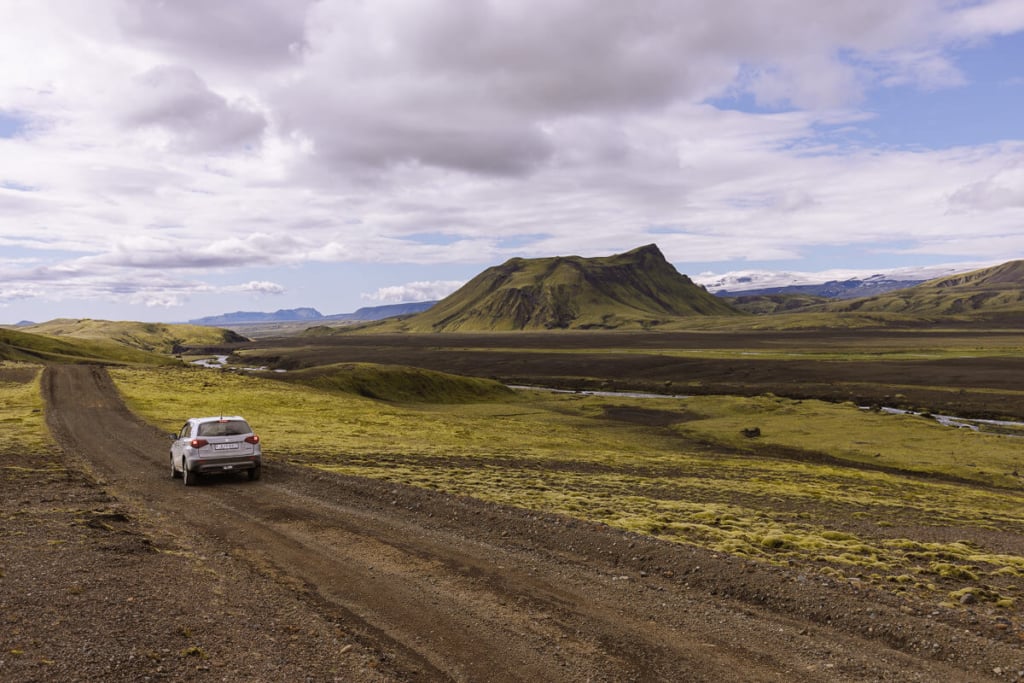
WHAT DID WE HIRE IN ICELAND AND HOW DID WE DO?
We wanted to explore the F-roads to see some of the highland’s amazing sights without spending a small fortune. After researching where we thought we would be able to get to and extensively comparing prices, we went for a medium size 4×4 with good clearance.
Our plan was to drive the easy mountain roads, assess the medium roads as we went, and avoid the difficult ones.
With our medium 4×4, we managed to get to every place listed on our Iceland Highlands guide except Thórsmörk where we took the Highland Bus. (We did drive out to the most difficult river crossing on a separate occasion and decided we made the right decision).
Most were fairly straight forward although the drive to Askja and Holuhraun had challenging river crossings, long sandy sections and lots of large rocks making it an exciting and nerve-wracking trip. It was at the upper limit of what our medium-sized 4×4 could handle
If a destination had multiple ways to get there, we generally took the easiest. You can find the route details and timings on our highlands guide and our overall route on our Iceland itinerary.
If you are not price-sensitive, the Toyota Hilux 4×4 Double Cab is a very good option. It’s a large 4×4 with high clearance that will enable you to try the more challenging F-Roads.



RENTING A 4×4 VEHICLE FOR THE F-ROADS
The best place to book your 4×4 vehicle for the F-roads is Lotus Car Rental. This is not an affiliate link, and we were not sponsored by Lotus. But, after extensive research, we decided they were the best option for hiring a car for the F-Roads simply because they are one of the few hire car companies who provide insurance for river crossings.
Their rental prices include free-pick up and drop off from the airport (5 minutes away), unlimited mileage, free cancellation with no deposit, third-party liability insurance, collision damage waiver, and theft protection.
Most importantly, they offer two types of additional insurance which is clearly explained:
Gold Insurance (+$20 per day) // Gold insurance covers gravel, sand and ash protection which is recommended in Iceland with their unique volcanic environment.
Platinum Insurance (+$40 per day) // Platinum insurance covers all the above, plus it covers vehicles on the F-roads including river crossings. Very few car rental companies supply insurance for crossing rivers. This means, if something goes wrong you could be liable for thousands or tens of thousands of dollars. Platinum Insurance also gives you a free internet hub to use in Iceland.
We took Platinum Insurance, and after driving to Askja, we were very pleased we did.
When selecting your car on the Lotus website, make sure you select the F-roads/4×4 checkbox and only vehicles allowed on F-roads will be shown. They have a good range of vehicles at competitive prices.
If you want to compare prices, please use RentalCars.com who will pay us a small commission if you book with them.


TIPS FOR DRIVING THE F-ROADS OF ICELAND
All our general tips for navigating the roads of this fantastic country are on our Driving in Iceland guide, but here are some additional tips that are specific for driving on the F-roads.
CHECK WEATHER & ROAD CONDITIONS
01 – Road conditions can change very quickly, so stay up to date at safetravel.is. At the end of this guide, we have a list of F-roads and how easy they are to drive under normal conditions.
02 – Weather conditions also change quickly so pack warm clothes, waterproofs and hiking boots or shoes. Check the Iceland weather forecast before you leave.
03 – Download Google Maps to use offline in Iceland. Google Maps gives decent timings for the easier F-roads under normal conditions, but if you are on a more difficult F-road in a smaller car you will need to add time. Similarly, if you are unfamiliar with river crossings or the weather is bad it will also add extra time.

MAKE TRAVEL PLANS
04 – Let people know where you are going. Tell family and friends your itinerary and each day inform your guesthouse/hotel owner where you intend to go, what route you are going to take and where you will end up. Also, submit a travel plan to the emergency services.
05 – Download the SafeTravel App onto your mobile phone. It helps you plan journeys and keeps you informed about road conditions. It also provides information on road signs. Safe Travel App Mac // Safe Travel App Google Play
TAKE SUPPLIES
06 – Leave with a full tank of petrol and monitor your fuel usage as you go. There are almost no petrol stations in the highlands and running out is not something you want to worry about.
07 – Take plenty of food and water with you for the trip. There are very few shops and restaurants in the highlands.
08 – Make you have a spare tyre that’s fully operational or a tyre repair kit and that you know how to use it.
DO NOT GO OFF-ROAD
09 – Driving off-road is illegal in Iceland so stay on the marked tracks at all times. Life is delicate in Iceland. Plants grow very slowly and can be destroyed quickly. This is particularly true in the highlands where life is often just beginning. Not only is off-road driving illegal it can set nature back hundreds of years.



HOW TO CROSS RIVERS IN ICELAND
The biggest challenge when driving on the F-roads in Iceland is crossing rivers. Most insurance policies do not cover damage caused during river crossings unless you take the Platinum insurance from Lotus. Therefore, you need to be very careful.
Fortunately, providing you have the correct vehicle and follow these guidelines, driving across rivers in Iceland is perfectly manageable – if a little nerve-wracking. The important thing to remember is if you are in doubt, don’t cross.
PICK YOUR DAY
A ) The depth and speed of river vary depending on the day and time of year. The rivers are faster and deeper after heavy rain, but also late on warm sunny days when glacial melt has run into the valleys. Ideally leave early on dry, cloudy, and cool days.
ASSESS THE RIVER CROSSING
B ) Do not try to cross a river where the water is higher than three-quarters the height of your wheels. Look for posts marking the depth; however, most rivers do not have them.
C ) Do not attempt to cross a river that is flowing fast. In general, if you are not happy to try to wade across do not try to drive across.
D ) The wider the river the more likely you are to build up a wave in front of you as you cross. So even if it is a bit shallower be extra careful on wider river crossings.
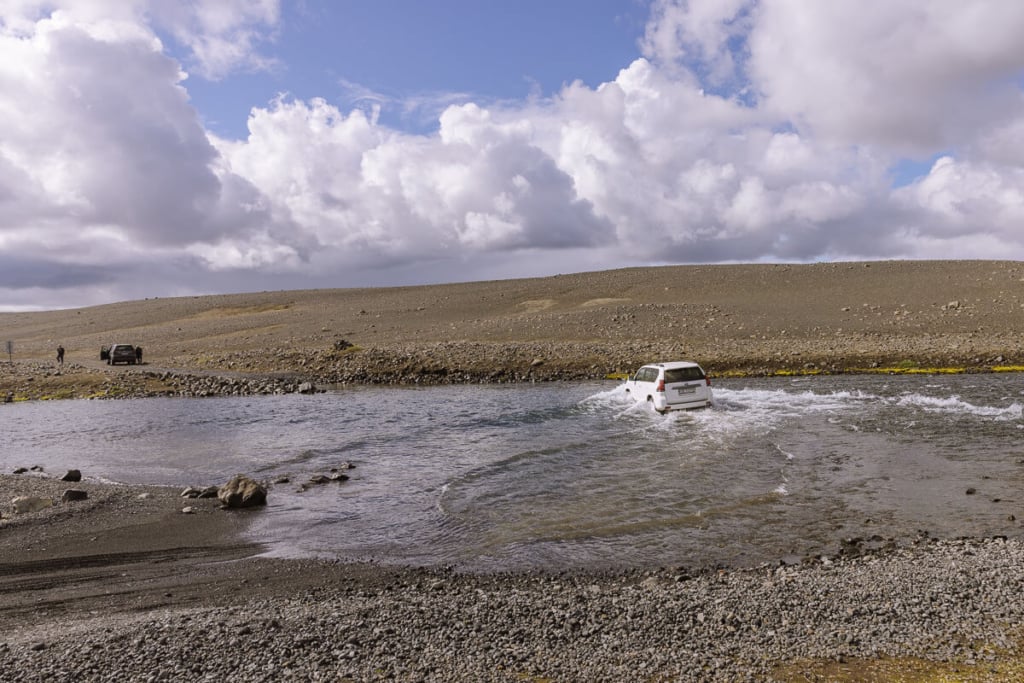
CHOOSE YOUR ROUTE ACROSS THE RIVER
E ) Choosing the correct route for the given conditions is one of the most important things to remember when crossing a river in Iceland. While the best route changes, here are some good guidelines.
F ) Sometimes the local ranger will place a rope across the river to indicate the best route. This is where you want to cross the river, even if it involves curving around a wider section.
G ) Lots of small ripples suggest shallower water with no large rocks underneath, making it a good point to cross the river. Still water is deeper; bigger ripples or waves suggest large boulders under the surface.
H ) Tyre marks entering and exiting the river may be a good indication of where other vehicles have gone, indicating the best path. However, be aware that this could be from a much larger vehicle that didn’t need to consider their route as carefully. Always assess the situation even if there are obvious tyre marks.
I ) The centre of the crossing is often deeper (because large, modified vehicles have driven straight across it and dug up the stones). It’s often better to stick to the edges.
J ) If the route is unclear it is usually better to start upstream and head diagonally downstream across the river. Going with the flow of the water is better than pushing against it and risking flooding the engine.
K ) If you are very unsure, wait for another car so you can cross together and keep an eye out for each other.
HOW TO DRIVE ACROSS
L ) Before entering the river ensure your vehicle is in a low manual gear and drive slowly (5 to 10 miles per hour) but without delay across the easier route of the crossing. The reason you want to be in low gear is to keep the revs high to stop water from entering the exhaust.
M ) Do not change gears mid-crossing, and don’t hesitate halfway through.



LIST OF POPULAR F-ROADS
While we haven’t driven all the F-roads in Iceland, we have driven quite a few; collecting information as we go. Here’s a list of the most popular F-Roads in Iceland, how difficult they are in normal conditions, and where they can take you.
DESTINATION: KERLINGARFJÖLL & THE CENTRAL HIGHLANDS
F26 (SPRENGISANDUR)
Sprengisandur is one of only two F-roads that go all the way across the highlands, connecting the northwest of Iceland with the Golden Circle and Reykjavík. There is only one major river crossing (about halfway along) but it can be unpredictable.
- Highlights – Aldeyjarfoss is a lovely waterfall close to the northern end, and Haifoss is a stunning long waterfall a short detour from the southern end.
- River Crossing – One medium to large river crossing.
- Vehicle Requirement – At least a medium-sized 4×4 SUV, sometimes a large 4×4.
F35 (KJÖLUR ROAD)
The F35 is the other F-road that traverses the country, but this one is much easier. Recently reclassified from F-35 to simply “35”, you still need a 4×4 to drive on it, but there are no river crossings and nothing particularly tricky. This is a great F-road for complete beginners.
- Highlights – Hveralvellir is an out-of-the-way hot spring, and Kerlingarfjöll Mountain Lodge is a short detour on the F347.
- River Crossing – None
- Vehicle Requirement – Any 4×4 SUV.
F347 (KERLINGAFJALLAVEGUR)
This short F-road connects the 35 Kjölur road to Kerlingarfjöll, a wonderful mountain range in a geothermal area. The first section is an easy gravel track with no river crossings. The second section from the mountain lodge to Hveradalir is rough and a little steep.
- Highlights – The geothermal area of Kerlingarfjöll is one of the best regions in the highlands. Additionally, Hveradalir is a 1-hour hike (each way).
- River Crossing – None
- Vehicle Requirements – Any 4×4 up to the Kerlingarföll mountain lodge.


DESTINATION: FJALLABAK NATURE RESERVE & LANDMANNALAUGAR
F208 NORTH (FJALLABAKSLEIÐ NYRÐRI NORTH)
This is another great road for first-timers on Iceland’s F-roads. Recently downgraded from F208 to just “208”, you still need a 4×4 SUV to drive on it, but there are no river crossings.
- Highlights – Sigöldugljúfur Canyon, Ljòtipollur Crater and (after a short time on the F224) Landmannalaugar. Read all about these amazing highlights in our Landmannalaugar Guide.
- River Crossing – None
- Vehicle Requirement – Any 4×4 SUV.
F208 SOUTH (FJALLABAKSLEIÐ NYRÐRI SOUTH)
In contrast to the F208 North, the F208 South is the toughest route into Landmannalaugar. It’s long and involves three sizeable river crossings (and many smaller ones). The first big river crossing is the Kylslahólmar and about 40 minutes later are the Halldórsdalur and the Kirkjufellfoss river crossings. They can be 40 to 60 centimetres deep and present quite a challenge.
- River Crossing – Three medium to large river crossings
- Vehicle Requirement – At least a medium, quite often a large 4×4.
F224 (LANDMANNALAUGAVEGUR)
This F-road is the short connecting road between the F208 and Landmannalaugar Camp Site. There is one medium-sized river crossing just before you reach Landmannalaugar, but if you don’t want to cross, park just before the river and walk across the pedestrian bridge. Read more about how to get to Landmannalaugar.
- Highlights – Driving into the otherworldly scenery of Landmannalaugar.
- River Crossings – One optional medium crossing.
- Vehicle Requirement – Medium 4×4 (large if you want to cross the river).
F225 (LANDMANNALEIÐ)
This is the F-road that connects Landmannalaugar with the west, and it has three or four river crossings all of which are usually small, making it a great road to practice your first river crossings. If you are off for a day hiking in Landmannalaugar, a great loop is to arrive from the north on the F208 and return via the F225.
- Highlights – The huge expanse of gravel beside the towering mountains of Langmannalaugar.
- River Crossings – Three or four usually small river crossings.
- Vehicle Requirement – Any size 4×4.


DESTINATION: THÓRSMÖRK, MAELIFELL & THE SOUTHERN HIGHLANDS
F249 (ÞÓRSMERKURVEGUR)
The F-road to Thórsmörk is one of the most challenging in Iceland. Early on there are a number of small rivers before reaching the Steinsholtsá and Hvanná crossings which require a large 4×4 and plenty of experience. Finally the main Krossá River is often a fierce torrent, requiring a specially modified vehicle.
- Highlights – Read our Guide to Thórsmörk for all the highlights, plus the different ways to plan your visit.
- River Crossings – Two large and one very large river crossing.
- Vehicle Requirement – Large 4×4 (modified super jeep for the Krossá River crossing).
F210 (FJALLABAKSLEIÐ SYÐRI)
This is a majestic road that connects the area north of Thórsmörk with the east. It has lots of small to medium crossings but two large ones stand out. In the west, the Kaldaklofskvisl river can be deep with hidden boulders and in the east, the Holmsá River can be both deep and wide. In between, there is slippery black sand and a boulder-strewn track that can be tricky to follow.
- Highlights – Most people come here to see the remarkable green volcano of Maelifell, but there is an easier way – all the details are in our Maelifell Volcano guide.
- River Crossings – 2 challenging river crossings.
- Vehicle Requirement – Large high clearance 4×4.
F232 (ÖLDUFELLSLEIÐ)
This is the easiest way to get to the base of the Maelifell volcano. The F232 leaves Highway 209 near Hrífunes and heads up the west side of the glacial valley of the Holmsá River. The three largest rivers (Leira, Jökullvisl, and Bláfellsá) have all been bridged and the road (when we took it) was in pretty good condition. There is one medium river crossing on top of the Bláfjallafoss waterfall.
- Highlights – As one of our favourite days in the highlands read all the details on our Maelifell volcano guide.
- River Crossings – 1 medium river crossing.
- Vehicle Requirement – Medium size 4×4 or larger.


DESTINATION: ASKJA & THE EAST HIGHLANDS
F905 (ARNARDALSLEIÐ)
This is a relatively easy F-road with stunning scenery. There are a couple of small river crossings and puddles but nothing difficult. Many use this road to connect to the F910 to drive to Askja.
- Highlights – The pointy mountains that rise above a mix of grey gravel and green meadows cut by sweeping rivers.
- River Crossings – a few small river crossings.
- Vehicle Requirement – Any size 4×4.
F907
This is an easy F-road that connects the eastern edge of the F910 with Route 1 in the North. We used a small section of this road to get from Stuðlagil Canyon to Askja.
- Highlight – The remarkable basalt columns of Stuðlagil Canyon.
- River Crossings – None.
- Vehicle – Any size 4×4.
F910 (AUSTURLEIÐ EAST) – BETWEEN KÁRAHNJUKAR DAM & THE F907
Between Kárahnjukar Dam and the F907, the F910 rises in an easy but bumpy progression along the eastern edge of the Vatnajökull glacier. It’s a scenically rewarding, remote drive that shows off Iceland’s many personalities.
- Highlights -Laugavallalaug Hot Springs is a stunning geothermal pool under a waterfall, and Hafrahvammagljúfur is a 200-metre-deep canyon.
- River Crossings – None.
- Vehicle Requirement – Any size 4×4.
F910 (AUSTURLEIÐ CENTRAL) – BETWEEN F907 & ASKJA
The F910 between the F907 and Askja, bumps over rocky lava fields, swerves through shallow sand, and crosses two medium-sized rivers. It’s a slow trip, but the views are exceptional.
- Highlights – The otherworldly landscapes heading towards Askja including the lava field you drive over and a huge expanse of sand and rocky boulders.
- River Crossings – Two medium river crossings.
- Vehicle Requirement – At least a medium, easier in a large 4×4.
F910 (AUSTURLEIÐ WEST) – ASKJA TO THE F26
Wild inhospitable and often remaining closed late into the year, the F910 west, goes to the new Holuhraun lava field created in 2014 and then under the flanks of Vatnajökull glacier. Very few people drive out here, so you will most likely be on your own. Ask the ranger for advice before heading off.
- Highlights – Seeing one of Iceland’s most recent lava fields in the middle of nowhere.
- River Crossings – At least two medium-to-large river crossings.
- Vehicle Requirement – Medium to Large 4×4.
F88 (ÖSKJULEIÐ)
The F88 is the other F-road that goes to Askja from the north. The F905/F910 (mentioned above) is a more interesting route but heading back on the F88 is a great loop. However, the rivers present a major challenge.
There are four river crossings in total, two small and two larger. They are not always more difficult than those on the F910 but they are more unpredictable. The main Lindaá crossing requires particular care as it’s very wide and often deep. Ask the rangers in Askja for advice before setting off.
- Highlight – Combine with F905/910 for a great loop to Askja.
- River Crossings – Two medium to large river crossings.
- Vehicle Requirement – Medium to Large 4×4.
F894 (ÖSKJUVATNSVEGUR)
The F894 is a short F-road connecting the F910 with the Viti Crater at Askja. It’s a 15-minute bumpy ride over a lava field. You can use any 4×4 on the F894, but you’ll need at least a medium one to get to it.
- Highlights – From the end of the F894 you can walk up to Askja Caldera and the Viti Crater which are geologically fascinating sites in Iceland.
- River Crossings – None.
- Vehicle Requirement – Medium to Large 4×4.


DESTINATION: LANGJÖJKULL GLACIER AND WEST HIGHLANDS
550 (KALDIDALUR)
A great way to experience the F-roads for the first time, the 550 Kaldidalur is just a short distance from the Golden Circle. It is a mountain road, rather than an F-road but you still need a 4×4 to drive it. There is nothing difficult and there no river crossings
- Highlights – The bleak and barren views heading towards the mighty Langjökull glacier.
- River Crossings – None.
- Vehicle Requirement – Any 4×4.
551
The 551 is a short mountain road that connects the 550 Kaldidalur with the edge of Langjökull glacier. From here, guided groups take mountain buses onto the ice cap and hike into the glacier. It’s a lovely short drive winding past waterfalls & canyons to the bright white of the glacier.
- Highlight – Walk to the edge of the Langkökull glacier or join a snowmobile tour.
- River Crossings – None.
- Vehicle – Any 4×4.



